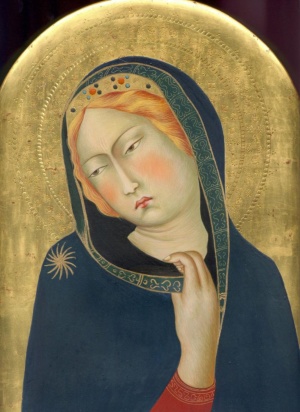Mother of God

Catholics believe that Mary is the sinless Mother of God; that she was sinless since conception; remained sinless throughout her life; and, as a result, was assumed into heaven when she died.
The notion of her sinlessness is often a subject of discussion and dispute; however, it has a very strong scriptural basis.
Mary’s fiat, found in Luke, Chapter 1:28, is held as one of the primary scriptural verses as to why Catholic and Orthodox Christians revere her. (Note, there is a huge difference between reverence and worship; worship is reserved for God, alone. Mary was a person, but very different from you or us.)
Much of the dispute about Mary involves the Angel Gabriel’s annunciation to her, in particular the dispute involves the translation of a word, kecharitomene, found in early Greek bibles.
Catholics believe that “kecharitomene” is correctly translated as “Full of Grace,” whereas others translate it as “Hail highly favored one,” and say nothing about grace, which has a precise meaning, i.e., sinless or extremely holy.
Given the Catholic interpretation, the question becomes when did Mary became free from sin?
The angel’s words to Mary did not say you will be full of Grace but you are “full of Grace.” This means, that, already, at the time of Gabriel’s appearance to her, she was full of grace, or absent from sin. Through deductive reasoning, we can conclude that she was sinless from conception, ergo her Immaculate Conception.
Mary as the New Eve
The Church also reveres Mary as the New Eve, faithful helpmate of the New Adam (see Saint Paul’s First Letter to the Corinthians 15:21-22, 45). Just as Eve’s infidelity brought about our fall from grace, Mary’s faithfulness at the Annunciation–, i.e., let it be done to me–(Luke 1:38) brought about our restoration.
She was the only person to directly participate with Her Son in the Redemption. As the Prophet Jeremiah wrote, “Return, O virgin Israel, return to these your cities. How long will you waver, O faithless daughter? For the Lord has created a new thing on the earth: a woman protects a man” (Jeremiah 31:21-22).1
Mary as the Ark (of the New Covenant)
In the Old Testament, God ordered that a special Ark made of pure, incorruptible materials be constructed to transport the Ten Commandments (see the Book of Exodus, 25:10). These tablets were holy because they had been touched by God Himself. It would not have been appropriate, therefore, for them to be carried in an ordinary container made of imperfect materials. Far less appropriate would it have been for Jesus, the Son of God, to be formed and carried in the womb of a sinner (see the Book of Wisdom 1:4 and the Letter of the Hebrews 7:26).
A direct parallel between the Ark of the Covenant and the Mary is found in the account of David transporting the Ark to Jerusalem and her visit with Elizabeth. Both accounts involve the land of Judah: see, for example the Second Book of Samuel 6:2 and Luke 1:39.
In 6:14 in the former account, David leaps for joy as the Ark enters the city, and in the latter, the babe in Elizabeth’s womb leaps for joy at the Virgin’s approach (Luke 1:41). In chapter six, verse nine, David asks, “How can the ark of the Lord come to me?”
In the early stages of her own pregnancy, Mary went to the hill country of Judah to assist her cousin Saint Elizabeth, who is also with child.
The sound of Mary’s greeting causes Elizabeth and her unborn baby to be filled with the Holy Spirit and she exclaims, “Blessed are you among women, and blessed is the fruit of your womb!” (Luke 1:41-42). That Saint John the Baptist is “filled with the Holy Spirit, even from his mother’s womb” (Luke 1:15) proves the possibility, if not the likelihood, of the Immaculate Conception. After all, if it was fitting for John, who would prepare the Lord’s way, to be sanctified in his mother’s womb, should not Mary, who would bear, care for, and raise Him, receive the same or even a greater blessing?
Analogously, Elizabeth asks, “Why is this granted me, that the mother of my Lord should come to me?” (Luke 1:43). Per the Second Book of Samuel (6:11), the Ark remains in the house of O’bed-e’dom for three months, and in Luke 1:56, the Virgin remains with Elizabeth for three months.
Coincidentally, a vision of the Mother of the Redeemer immediately follows Saint John’s vision of the Ark of the Covenant in Revelation (see 11:19-12:1).
- “Mary alone co-operat(ed) with the pre-arranged plan,” remarked Saint Irenaeus of Lyons in about 185 in his Against Heresies (3:21:7). The New-Eve tradition was taught throughout the ancient world from a very early date—in Rome and Asia Minor by Saint Justin the Martyr, in Gaul by Saint Irenaeus, in Northern Africa by Tertullian, and in Alexandria by Origen—proving it had been propagated by the Apostles themselves.
Implicit in the New Eve teaching is the understanding that Mary possessed the purity of Eve before the Fall, that she had been spared Eve’s fault, or original sin. “Mary, is on the one hand, a replica of Eve in her purity and integrity before the Fall,” Ludwig Ott observed, “on the other hand, the antitype of Eve, in so far as Eve is the cause of corruption, and Mary the cause of salvation” (Fundamentals of Catholic Dogma, TAN Books and Publishers, 1960, p. 201). ↩